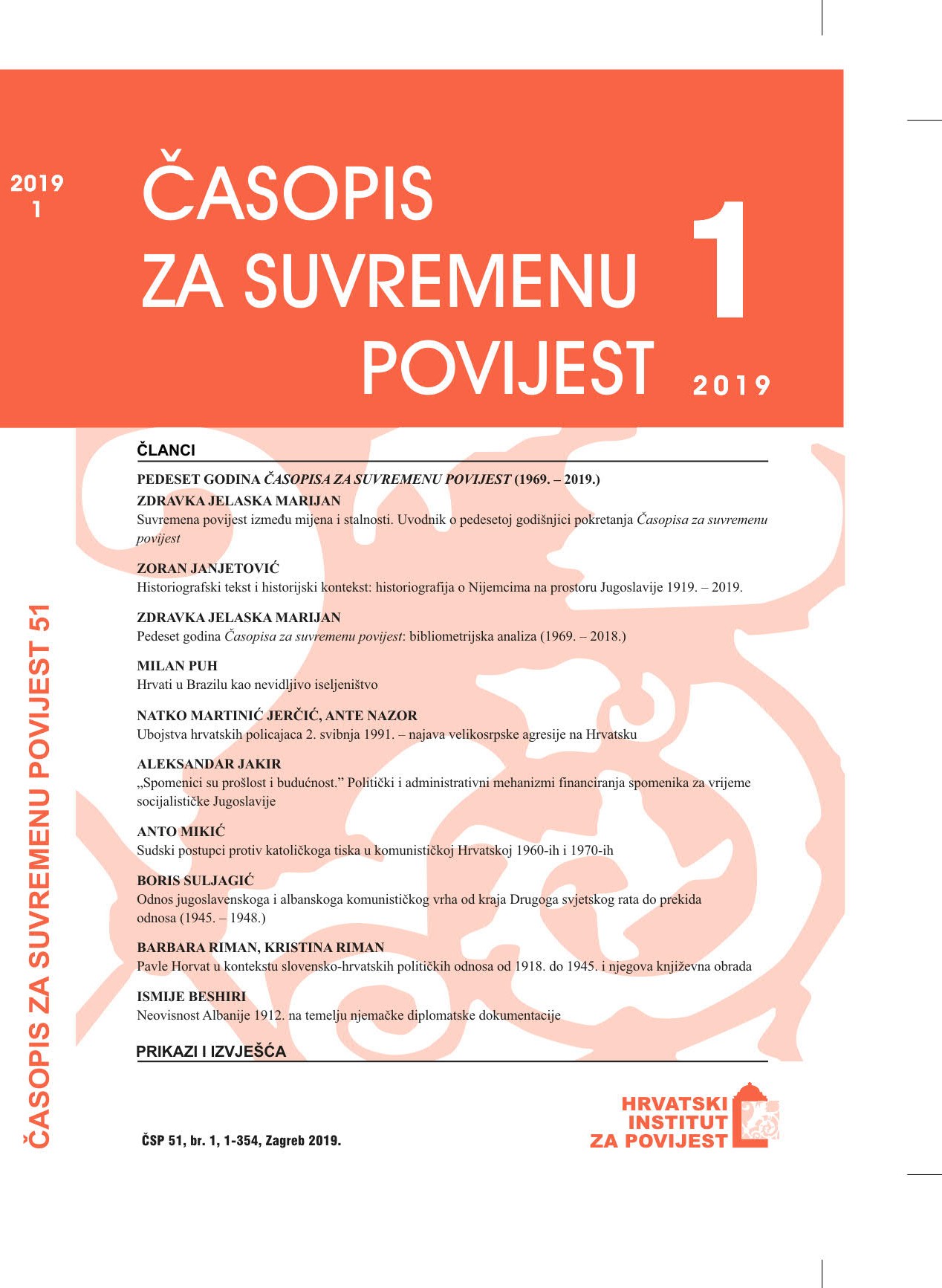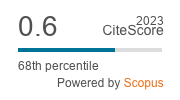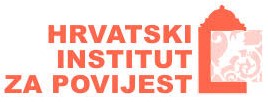“Monuments are the Past and the Future”. Political and Administrative Mechanisms of Financing Monuments during Socialist Yugoslavia
DOI:
https://doi.org/10.22586/csp.v51i1.8293Keywords:
socialist monuments; memorial culture; Battle of Sutjeska; memorial complex in TjentišteAbstract
The intent of this paper is to provide a contribution to the discussion of socialist monuments during the time of socialist Yugoslavia based on the recent literature dealing with the study of memory culture as well as sources from various fonds stored in the Yugoslav Archives in Belgrade, by displaying some of the political and administrative mechanisms of the funding of these monuments within the federal Yugoslav system. Also discussed are questions about the attitudes towards monuments within this period from the perspective of memory culture, and how it was propagated from central state institutions during the time of socialist Yugoslavia. Special attention is given to, as it is has often been called, the most famous Partisan monument on the territory of the former Socialist Federative Republic of Yugoslavia, the sculpture devoted to the “Battle of Sutjeska” by Miodrag Živković at Tjentište, from 1971.
During the period of socialist Yugoslavia, an exceptionally large number of “socialist monuments” were built, and numerous sculptors and other artists participated in this endeavour with their sculptures. By 1961, censuses had already counted more than 14,400 monuments and memorials on the entire area of the country. The sources from the Yugoslav Archives in Belgrade used in this article, such as materials from the Presidency of the National Assembly, as well as documents from the Federal Council and the Federal Secretariat for Education and Culture, underline the thesis that the ruling structures in socialist Yugoslavia were aware of the importance of monuments as the most visible expressions of the then desirable socialist interpretation of history. Such materials confirm what the literature on the topic has already shown, that monuments after 1945 were usually raised at the initiative of local communities or local authorities. In the first wave of building new monuments, as early as the spring of 1945, monuments of gratitude were erected and devoted to the fallen soldiers of the Soviet Red Army as well as to victims of war and terror who had been on the side of Tito’s victorious forces. The unveiling ceremonies for such monuments were held in the presence of the highest officials of the new regime, and elaborate protocols were designed, showing an abundance of various elements by which the new ideological code was brought forward.
After the consolidation of power, it was not just local communities, but now also socialist enterprises who expressed the willingness to build monuments, as evidenced by the example of the installation of the monument to the “People’s Hero Rade Končar” at the electrical machinery factory bearing his name in Zagreb in 1952. However, questions of financing these monuments, as is shown in this paper, generated frequent debates in the following years, especially when it came to monuments that were considered to be of general Yugoslav importance. Also, in 1952 the Federation of Veterans’ Associations of the People’s Liberation War of Yugoslavia (SUBNOR) established a Committee with the task of deciding what were the most important historical sites connected to the People’s Liberation War and to what was called the “People’s Revolution” in Yugoslavia. This Committee was fully funded from the federal budget and its task was to prepare the erection of central war memorials. Hence, as documents from state bodies such as the Federal Executive Council in Belgrade indicate, issues of financing monuments from the central state level were not always easy to resolve within the federal system. Central institutions were prompted by local requests for financing socialist monuments. Although the federal authorities took the view that, in general, financing the erection of monuments was not the business of central but of local authorities as well as those on the level of the republics, and they said that requests for financial aid for monuments of Yugoslav importance should be referred to the Committee (knowing, of course, how little money the Committee had at its disposal; it was entirely dependent on federal funds), frequent requests from all parts of Yugoslavia were received. It was often pointed out in the correspondence that the Federal Executive Council could not finance the construction of monuments and memorial complexes because of the decentralized structure of the state, and that republics and committees should decide on the monuments while the Yugoslav Federation pursues its policy exclusively through SUBNOR. However, due to strong pressure, in the end the federal budget still provided significant funds, as can be seen from the materials of the Budgetary Commission.
When it came to “the most prominent personalities of the Yugoslav revolution”, especially in the areas of underdeveloped municipalities, funds from the federal reserve budget could be made available for monuments. As a report “on the Participation of the Federation in the Construction of Monuments and Other Objects Concerning the Marking of Events from the People’s Liberation War” clearly shows, there were many “exceptions in terms of deviation” from the rule that the federal government did not have jurisdiction over. The government argued that monuments had to be financed from the municipalities or republics, and that “exceptions can be made only in cases involving events of interest to the entire country, or when it comes to persons who were at the highest functions in the federation”. So, it turned out that federal funding was nevertheless possible for “important monuments”. Federal authorities frequently discussed funding, but also debated about “the problems of the valorisation of cultural monuments, with particular reference to the monuments of the People’s Revolution”. The design and funding of the memorial complex at Sutjeska is considered as an example of this in the paper.
The Sutjeska monument can be considered paradigmatic in relation to a desired memory culture from the perspective of government, that is, from the aspect of the state and state institutions. The artistic solution for the monument at Tjentište by sculptor Miodrag Živković was accepted as a perfect symbol and artistic expression of the “inescapable meaning of Sutjeska”. The Battle of Sutjeska in 1943 was considered to be “a glorious historical example with far-reaching consequences, exalted and unique”. It can be said that it is still the most famous Partisan monument on the territory of the former socialist Yugoslavia. Sutjeska as a place of memory and a site for a memorial complex was mentioned for the first time in 1954. After Josip Broz Tito personally endorsed the ultimate design concept, his role, as cited in the paper, was evidently also crucial in adopting the law on financing the works on the memorial complex in Sutjeska. Formally, the central government had to negotiate and determine the level of republican involvement in financing the complex but, on 4 March 1968, SUBNOR sent an elaborate draft financing the bill for the design of the memorial complex in Sutjeska, with an explanation and review of the necessary investment, clearly mentioning a meeting with Tito during which the lifelong president of Yugoslavia made his decision about the matter. The design of the memorial complex at Tjentište, a place where, without any source references, it was claimed that there were “5,000 buried soldiers”, was entirely financed by federal funds amounting to approx. 57.8 million dinars. The monument was officially unveiled under the name “Monument of Victory” in 1971 in the presence of Josip Broz Tito. However, in an increasingly decentralized system, actors such as SUBNOR feared that building the memorial complex could be called into question for financial reasons, so it was quick to reveal the monument, even though the entire complex was not yet fully completed. A justified conclusion seems to be that, at the beginning of the 1970s, “brotherhood and unity” was, at the symbolic level of course, the official motto of the socialist federation of Yugoslavia, but demands for “clear accounts” within the federation were applied to all financial issues, not excluding the financing of monuments and memorial complexes of common Yugoslav significance. It is also possible to ascertain that, when it comes to socialist memory culture, members of the victorious Partisans during the war as well as representatives of the governing structures after 1945 did not manage to pass what they wanted to become a memory on to new generations, not even through the impressive and artistically successful grand monument to the Battle of Sutjeska. Nonetheless, it can be stated that the dominant interpretation of the Battle in the post-Yugoslav context, as recent examples show, remains within the framework of what was emphasized at the time when the monument was placed in Tjentište. In the eyes of many in the South Slavic areas, Sutjeska still represents a symbol of the sacrifice, brotherhood and unity of the heroic anti-fascist struggle, marking a milestone on the path to the victory of Tito’s Partisans in the People’s Liberation War, 1941–45.
Downloads
Published
How to Cite
Issue
Section
License
Copyright (c) 2019 authors and journal

This work is licensed under a Creative Commons Attribution-NonCommercial 4.0 International License.
Copyright holders are the publisher Croatian Institute of History and the authors. Journal of Contemporary History is an Open Access journal. Users are allowed to read, download, copy, redistribute, print, search and link to material, and alter, transform, or build upon the material, or use them for any other lawful purpose as long as they attribute the source in an appropriate manner according to the Creative Commons licence CC BY-NC. The papers published in Journal of Contemporary History can be deposited and self-archived in the institutional and thematic repositories providing the link to the journal's web pages and HRČAK. Journal does not charge article processing charges (APC). The editors assume no responsibility for statements of fact or opinion made by contributors.




